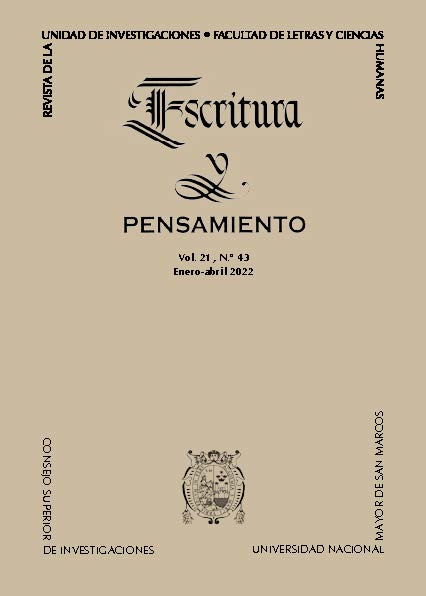The graphic heritage of the tocapus in the pallay of Chinchero fabrics
DOI:
https://doi.org/10.15381/escrypensam.v21i43.21873Keywords:
tocapus, textile iconography, Chinchero, pallay, graphic continuityAbstract
In Ancient Peru, the importance of textiles is distinguished by their high quality and aesthetic richness, but above all by their function as a support for the transmission of information and as a complement to oral memory. Within the variety of images represented in this medium, the tocapus stood out, a graphic language that during the Tahuantinsuyo was part of a communication system (Eeckhout 2004). The meaning of the tocapus was lost (Murúa, ([1613] 1946), however, during the colony it maintained a continuity of representation in the fabrics and in the keros. Our objective is to identify the relationships of the Inca tocapus and its link with the graphic language of the Pallay in the textile community of Chinchero, one of the main pre-Hispanic foci of fabric production in the department of Cusco. This research is descriptive in nature. We carried out a formal analysis of an Inca fabric with Tocapus and obtained compositional patterns that we used to compare with the current textile iconography of Chinchero. For this we have based ourselves on ethnohistoric sources, literature on visual syntax and semiotics of the image, as well as field work carried out in textile centers of the community. The results obtained allow us to infer that the graphic language of the tocapus remains in the Andean designs, as a visual vestige that was modified and adapted to the new narratives of the Andean social context through the centuries.
References
Arnold, D. y Espejo, E. (2012). Ciencia de tejer en los Andes: Estructuras y técnicas de faz de urdimbre. La Paz: Instituto de Lengua y Cultura Aymara.
Castañeda, S., Cáceres, R. y Peña, D. (2019). Tejiendo la vida. Los textiles en Q’ero. Dirección Desconcentrada de Cultura Cusco.
Choque, A. (2014). El proceso de creación artística en el Antiguo Perú. Arqueología y Sociedad 27 (29-36). Lima: Universidad Nacional Mayor de San Marcos.
Del Solar, M.E. (2017). La memoria del tejido: Arte textil e identidad cultural de las provincias de Canchis (Cusco) y Melgar (Puno). Soluciones Prácticas.
Frame, M. (1994). Las Imágenes Visuales de Estructuras Textiles en el Arte del Antiguo Perú . Editorial Revista Andina
Gentile, M. (2010). TOCAPU: unidad de sentido en el lenguaje gráfico andino. Espéculo. Revista de estudios literarios. Universidad Complutense de Madrid
Groupe Mu (2010). Tratado del signo visual. Para una retórica de la imagen. Editorial Cátedra Signo e Imagen.
Murúa, M. ([1613] 2001). Historia General del Perú. Dastin Export
Panofsky, E. ([1932] 2001). Estudios sobre iconología. Alianza Editorial.
Silverman, G. (1994). Iconografía textil Q'ero vista como texto: leyendo el rombo dualista Hatun Inti. Boletín del Instituto Francés de Estudios Andinos 23: 171-190. IFEA
Sinclaire, C., Brugnoli, P. y Hoces, S. (2006). Awakhuni, tejiendo la historia andina. Museo Chileno de Arte Precolombino.—.(2016). La generación literaria peruana. Escritura y Pensamiento, 39, 235-264.
Oviedo, J. (1972). Jorge Eduardo Eielson o el abismo de la negación. Eco, 141-142, 191-196.
Rebaza, L. (Comp.) (2013). Ceremonia comentada: otros textos pertinentes (1948-2005). 57 años de crítica a la obra visual de Jorge Eduardo Eielson. Lima: Lápix editores.
Vásquez, J. (2016). Tener hambre de luz y devorar una estrella: la poesía de J.E. Eielson. (Tesis Doctoral en Literatura). Universidad Complutense de Madrid, Facultad de Filología, Madrid. https://eprints.ucm.es/id/eprint/40126/1/T38021.pdf
Downloads
Published
Issue
Section
License
Copyright (c) 2022 Luis Kimil Valle Sánchez

This work is licensed under a Creative Commons Attribution 4.0 International License.
AUTHORS RETAIN THEIR RIGHTS:
a. The authors retain their trademark and patent rights, and also over any process or procedure described in the article.
b. The authors retain the right to share, copy, distribute, execute and publicly communicate the article published in the Escritura y Pensamiento (for example, place it in an institutional repository or publish as part a book), with acknowledgment of its initial publication by Escritura y Pensamiento.
c. Authors retain the right to make a subsequent publication of their work, to use the article or any part of it (for example: a compilation of their work, lecture notes, thesis, or for a book), provided that they indicate the source of publication (authors of the work, journal, volume, number and date).





